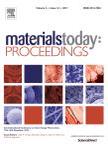版权所有:内蒙古大学图书馆 技术提供:维普资讯• 智图
内蒙古自治区呼和浩特市赛罕区大学西街235号 邮编: 010021

作者机构:Panjab University SSG Regional Centre Hoshiarpur 146020 India UIET Panjab University 160014 Chandigarh India
出 版 物:《Materials Today: Proceedings》
年 卷 期:2020年第28卷
页 面:1307-1313页
学科分类:08[工学] 0805[工学-材料科学与工程(可授工学、理学学位)] 080502[工学-材料学]
主 题:T a T s , T ia , Ambient dry bulb, solar-air and indoor air temperature respectively (°C) α I l , Absorptance of surface for solar radiation and total incident solar load respectively h i h o , The film coefficient of the indoor airand outside air over the building respectively (W/m 2 K) δR εδR/h o , Difference of longwave radiation incident on the surfacefrom the sky & surroundings and the radiation emitted by black body at outdoor air temperatureand long wave radiation factor U r , U w U wi , Overall heat transfer coefficient for roof, walls and windows respectively (W/m 2 K) A r A w , A wi , Area of the roof, walls and windows respectively (m 2 ) E f C es , Carbon dioxide emission factor, carbon dioxide emission reduction (kg/month) respectively L di ,L tr Distribution, transmission losses factor respectively τ Transmissivity of the window glass T sr T sw , T swi , The solar-air temperature of the roof, walls and windows respectively (°C) E s Monthly energy savings (kWh/month) Q net Q netl , Q nets , Net heat flow to the building (W) V ia ρ ia, Volume of room air(m 3 ) and density of room air (kg/m 3 ) respectively C ia M ia , Specific heat of room air (kJ/kgK) and mass of room air (kg) respectively N The number of air changes per hour Time variation of room air temperature b Coefficient of indoor air temperature δ 1 ,δ 2 ,δ 3 the thickness of cement layer,cement - concrete layer and brick layer respectively (m) K 1 ,K 2 ,K 3 Thermal conductivity of cement, cement - concrete and brick layer respectively (W/mK Solar absorptance Indoor air temperature Solar air temperature Energy efficient buildings Cooling load Light colored buildings
摘 要:A large amount of heat gets transferred to the indoor air of a building from outside in summers. Thermal comfort is measured using the indoor air temperature as main parameter. In northern India the indoor air temperature is very high and uncomfortable to the occupants. The air conditioners used for space cooling consumes a large amount of electric energy mainly produced from fossil fuels which gives rise to a lot of pollution. The heat gain by a building can be reduced by using light colors on the building exterior materials. In the present study the thermal comfort in buildings with different light colors has been evaluated and compared. The solar air temperature increased during the day time for all the light colors. The highest solar air temperature was for sand color and lowest for white color and for other colors it was in between these two. The net heat gain was witnessed during the day and in the evening and net heat loss was witnessed in the night and morning for all colors. The net heat gain was greatest for sand color and smallest for white and yellow color. The indoor air temperature increased during the day & in the evening and decreased in the night & in the morning for all colors. The indoor air temperature was maximum for sand color and minimum for white and yellow color. The maximum difference of indoor air temperature for sand & white color and that for sand & yellow color was around 0.9 °C and 0.7 °C respectively. Energy savings and carbon dioxide emission reduction is also achievable for light colors especially white and yellow colors. Therefore the white and yellow colored buildings are more comfortable for the occupants to some extent, the cooling load is lesser and these are friendlier to the environment.